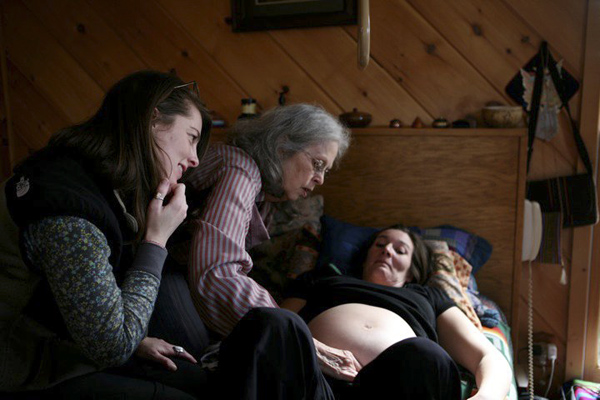
A scene from BIRTH STORY: INA MAY GASKIN & THE FARM MIDWIVES (Reckon So)
Birth Story: Ina May Gaskin & the Farm Midwives tells two linked stories that are impressive but end up at cross-purposes: a biography of a steadfast hippie who helped found a long-lasting, rural commune, alongside an educational advocacy primer on the role of midwives during childbirth.
Ina May Gaskin, introduced as “the most famous midwife in the world,” has presided over 1,200 births, written four influential books, including Spiritual Midwifery, and lectured around the world. Between helping expectant mothers at the Farm’s Midwifery Center in Tennessee and lecturing against the rising scourge of Cesarean-sections, she describes her negative experience with her own first-born delivered by a condescending male obstetrician, who insisted on using forceps.
Her life changed when she met the man who would become her second husband, Stephen Gaskin. He appears in black-and-white clips from the late 1960s as a guru with a loyal flock of hippies at an experimental college in wear-a-flower-in-your-hair San Francisco, talking of taking mind-expanding drugs to get in touch with his spiritual self.
They set off on a cross-country bus caravan to promote non-violence, similar to, if not the same one, described in Saint Misbehavin’: The Wavy Gravy Movie (2010). Women participants wax brightly about how wonderful it was that they all started having babies and how beautiful it was that they all pitched in and helped each other, sounding like pioneer women in Conestoga wagons. After Stephen led them away from the negative vibes in Haight-Ashbury in 1971, Ina May decided to get serious about learning midwifery and training other women to help. (There’s a clip of Walter Cronkite bemusedly covering the commune’s arrival in Tennessee.)
Directors Sara Lamm and Mary Wigmore draw on decades of video archives to demonstrate Gaskin’s patient, woman-centered, relaxed method of guiding childbirth, amidst the usual period clips of long-haired, back-to-the-land acolytes in meditation circles, planting and harvesting gardens for a vegetarian intentional community, as they now call it (all under Stephen’s direction, implicitly supporting the ex-Farmers’ circumspect explanations of why they left). While many births are seen up close, the lengthy documentation of two difficult births usually considered too high risk for out-of-hospital delivery are fascinating to watch, particularly as Gaskin explains she learned one of the helpful birthing positions from a Guatemalan midwife at an international conference. (I was reminded of feminist artist Judy Chicago’s challenge that if “men had babies, there would be thousands of images of the crowning.”)
But with the focus on Gaskin’s publications (including her rhetoric about the spiritual energy of childbirth), there’s no reference to other influences that have promoted the use of midwives, particularly the Boston Women’s Health Book Collective’s Our Bodies, Ourselves, no mention of the natural childbirth movement, as shown in The Business of Being Born (2008), or the interest spurred by the colonial midwife in Laurel Thatcher Ulrich’s 1991 Pulitzer Prize-winning A Midwife’s Tale: The Life of Martha Ballard, Based on Her Diary, 1785-1812.
Rather than encouraging women to turn to midwives, this documentary ends up reinforcing every stereotype, almost to the point of satire, of midwifery and out of hospital birthing as more appropriate to a hippie lifestyle (or for the Amish, who constitute half of the Farm’s clients). Although Gaskin mentions problems with insurance and doctor-led anti-midwife legislation, there are other issues. My two births were at an independent midwives’ birthing center for low-risk births in Manhattan set up by insurance companies as a model to challenge the high prices and rising C-sections at hospitals, but the facility was pressured to shut down by hospitals threatened by more inexpensive competition.
The score by the neo-folky Fleet Foxes’ Robin Pecknold reinforces the period feel, but watch through the credits to see three gray-haired Farm midwives sing Bonnie Lockhart’s “Who Were the Witches?,” sounding like a joyous alternative to Macbeth. The song links today’s midwives to past millennia even more so than the film: “When women had babies the witches were there/To hold them and help them and give them care./Witches knew stories of how life began./Don’t you wish you could be one? Well, maybe you can!” (The documentary will also have a digital release for Mother’s Day.)






Leave A Comment